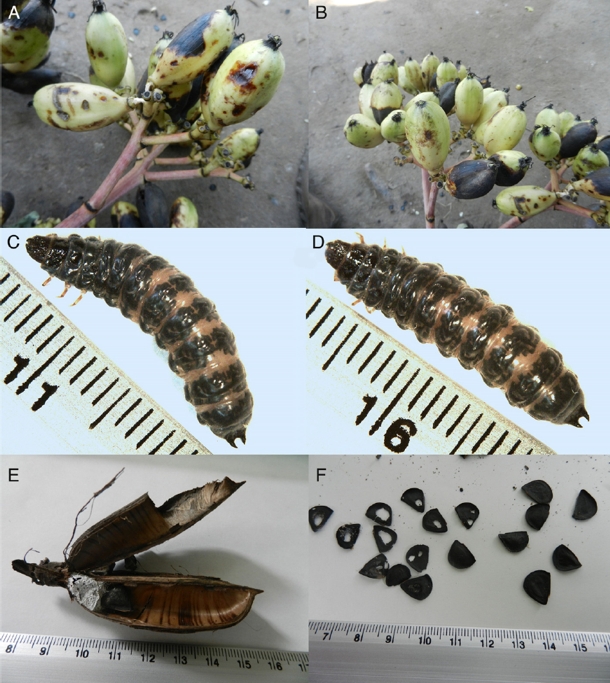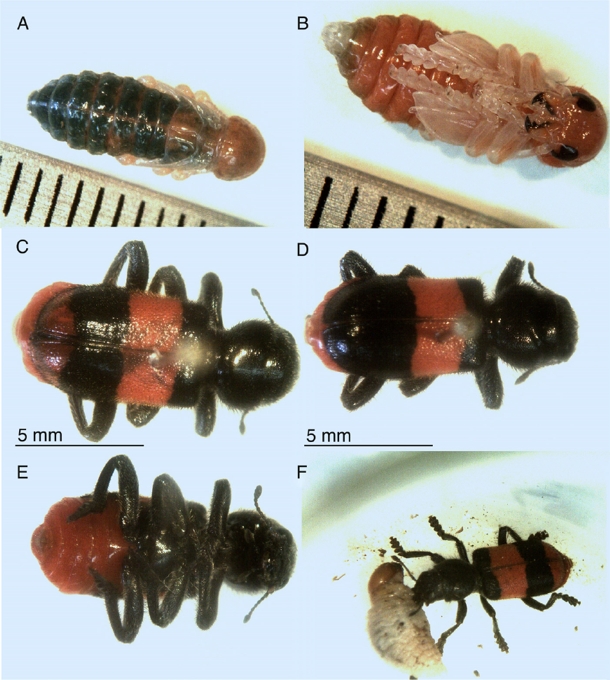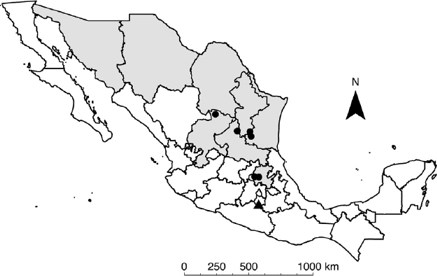Enoclerus zonatus (Klug) (Coleoptera: Cleridae) is a predator of insects associated with Asparagaceae in northern Mexico (Guerrero, Juárez, & Acevedo, 1985). Older studies reported the beetle feeding on weevils (i.e., Peltophorus polymitus Boh.) and borers within flowers, fruits, leaves, pods, stems, stalks, and seed clusters of Yucca and Agave spp. in Mexico and the United States (Foster, 1971; Foster & Barr, 1972; Guerrero et al., 1985; Mawdsley, 2002). However, many of these records were erroneously assigned to E. zonatus as a result of misidentifications. Our current concept of E. zonatus restricts its distribution to northern and central Mexico. In October 2015, during insect pest samplings in a 4-yr-old mezcal maguey (Agave vivipara L. = A. angustifolia Haw.) plantation (El Rancho Frío) located in Quetzalapa, Huitzuco de los Figueroa, Guerrero (18°23’12.4” N, 099°09’58” W, 1120 m asl), the first 3 authors observed maguey fruits (bolls) bearing signs of infestation (small holes with necrotic areas) (Fig. 1A and B). One stalk was collected (October 2, 2015) bearing approximately 3 kg of immature fruits (light green color; with holes); these fruits were placed in plastic containers (2 L) and maintained under laboratory conditions (Cuernavaca, Morelos, Mexico). Weekly observations were recorded to check for insect emergence.

Figure 1. Agave fruit (bolls) with small holes and necrotic areas (A, B). Infested bolls yielded Enoclerus zonatus larvae (C, D). Pupal chamber of E. zonatus in base of boll (E). Damage to agave seeds presumably by seed feeding weevils (F).
Larvae (Fig. 1C and D) of a beetle were recorded from October 5, 2015 to April 3, 2016. On November 3, 2015, the first pupal chamber was observed inside a boll. Pupal chambers were whitish, fibrous, 1–2 mm in thickness, and were constructed mainly in basal boll areas, although in some cases in the middle (Fig. 1E and F). First pupa (Fig. 2A and B) was observed on April 4, 2016. The timing of adult emergence was not uniform: the first adults (Fig. 2C–E) emerged on April 26, 2016 and the last adult emerged on May 3, 2016. The entire developmental cycle of the insect occurred inside the boll. Usually one adult, and less frequently 2 adults, emerged from a single boll. The emerged adults were placed individually in a glass container (size 150 mL) with small holes (2 mm diameter) in the top, and were fed with abdomens of adult cactus and agave weevils, and with larvae of agave weevils (Fig. 2F). Specimens were preserved in 70% alcohol, pinned, and identified by Víctor H. Toledo and Jacques Rifkind. Voucher specimens were deposited in the Colección de Insectos (CIUM) del Centro de Investigación en Biodiversidad y Conservación de la Universidad Autónoma del Estado de Morelos, Cuernavaca, Morelos.

Figure 2. Enoclerus zonatus: pupa, dorsal view (A); pupa, ventral view (B); adult, dorsal habitus (C, D); adult, ventral view (E); adult feeding on larva of Scyphophorus acupunctatus in laboratory (F).
Specimens were identified as Enoclerus zonatus (Fig. 3A–D), a clerid beetle predator (Guerrero et al., 1985; Waring, 1987), previously collected from Chihuahua, Coahuila, Hidalgo, Nuevo León, Tamaulipas, and Zacatecas (Barr, 1975). The present Guerrero record expands its distribution to southern Mexico, into the Balsas Basis biogeographic province (Fig. 4). This distribution could be the result of a close relationship to insects associated with Asparagaceae in Mexico.

Figure 3. Enoclerus zonatus: specimen with single antemedian red fascia (A, B); specimen with antemedian and posterior red fasciae (more common morph) (C, D).

Figure 4. Distribution of Enoclerus zonatus in Mexico, based on state (gray color) or localities records (black dots) (Barr, 1975; Guerrero et al., 1985, and material deposited in CIUM). New locality record indicated with black triangle.
E. zonatus belongs to a group of similarly marked (boldly colored in red and black), shining and robust Enoclerus species, all of which appear to be associated with species in the plant genera Agave and Yucca (Asparagaceae). The group includes E. agave Barr, E. spinolae (LeConte), E. vernalis Barr and Rifkind, and E. zonatus. E. zonatus is distinguishable from these congeners by its broadly darkened elytral base, and its postmedian elytral black marking in the shape of a transverse fascia. In addition, it has a more southerly distribution than E. spinolae and E. vernalis (Barr & Rifkind, 2009).











 nueva página del texto (beta)
nueva página del texto (beta)


